Mastering Outdoor Lighting: The Ultimate Landscape Guide
Table of Contents
Landscape lighting is more than just illuminating your outdoor space; it’s an art that balances aesthetics, safety, and function. The ‘Ultimate Guide to Landscape Lighting’ delves deep into the intricacies of outdoor illumination, offering expert tips, design principles, and product recommendations. Whether you aim to create a serene nocturnal oasis or enhance the security around your property, this comprehensive guide provides you with the tools and knowledge needed to transform your outdoor environment. Explore the transformative power of strategic lighting and elevate your landscape’s ambience during twilight hours.
Rest easy because, as always, we’re here to guide you. This handbook has all the insights you need to transform your front yard and backyard into stunning spaces. So, let’s dive in.

What is Landscape Lighting?
Landscape lighting is a form of decorative outdoor lighting typically installed along walkways, on porches, and in other areas surrounding the home. Landscape lighting can be used to highlight or add interest and character to various landscape features such as trees, shrubs, and ponds. Many different types of landscape lighting include spotlights, floodlights, and light-emitting diodes (LEDs) that can be used as a more energy-efficient alternative to conventional bulbs.
The Significance of Landscape Lighting
Landscape lighting is pivotal in elevating the aesthetic appeal of any space. Everyone aspires for their home to radiate elegance, and landscape illumination is the quintessential method to achieve that. Proper lighting can metamorphose an ordinary garden or yard into a mesmerizing retreat.
Beyond aesthetics, the ambience created by landscape lighting directly affects moods. Lackluster lighting often emanates a dreary atmosphere, encapsulating you in melancholy. On the other hand, a brilliantly illuminated space exudes vibrancy, uplifting your spirits.
Additionally, well-lit landscapes leave an indelible impression on visitors. Our memory often associates places with the emotions they evoke. Therefore, a home that radiates positivity will be etched in the minds of visitors as a delightful haven.
From a pragmatic perspective, landscape lighting also serves as a security measure. It not only deters intruders but ensures they can be easily spotted.
Benefits of Landscape Lighting
There are many benefits associated with landscape lighting for homeowners, which we will mention below.
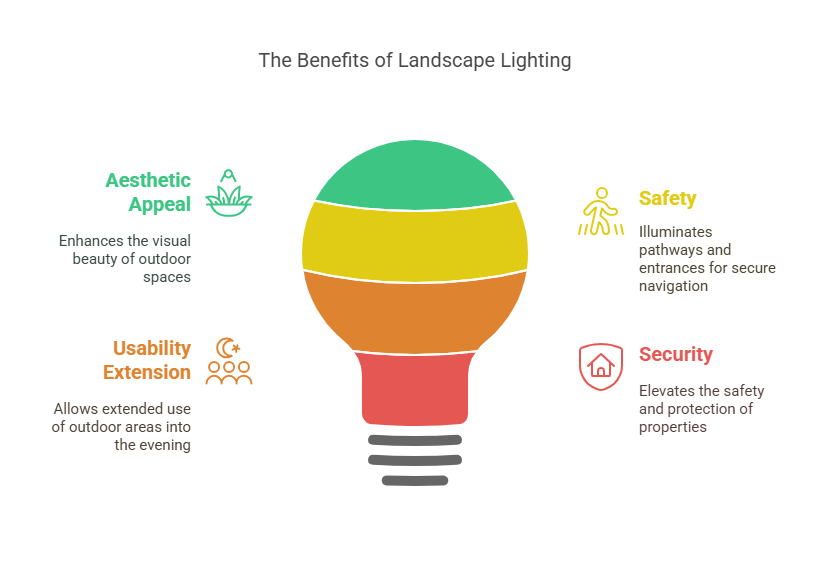
An improved aesthetic appeal
Lights improve the look of your outdoor area by illuminating darkened areas to achieve a better overall appearance. In addition to seeing a difference in the overall look of your property, you will also see a difference in your lawns and gardens.
Your neighbors are bound to love how your home shines brightly at night. All you need to do is put outdoor lighting around the house, either in the front or the back, and you’ll get the best outcome possible.
Highlights
The right amount of brightness outdoors can enhance your landscape’s overall appeal, especially if you have a lot of multi-shape trees or a fountain.
But to avoid forgetting the minor details, some, like viewing angles, may make a massive difference to how you do your tree lighting, but I’ll cover more later.
Landscape lighting enhances security.
Many homeowners worry about the safety of their properties because the possibility of burglaries, ft, or other similar crimes is so prevalent.
Installing a security and alarm system might be an excellent way to enhance how your yard or ground looks, but to make things safer, think about light fixtures around your trees.
Makes the most of outdoor space
In addition to creating visual interest, outdoor spaces can make your property look much bigger than it is.
You must create a focal point to create a moonlight effect in your garden. Adequately placed lighting fixtures can improve how large or small your property looks.
Maintain an inviting and presentable exterior.
If you’d like to improve your curb appeal, add a light display on the Christmas tree! Most homes look lovely during the day but lose their grandeur at night due to insufficient lighting. Installing landscape lighting will significantly improve your home’s appearance and curb appeal. You must wait and see how your place stands next to the outside world.
Selecting the Ideal Spots for Landscape Lighting
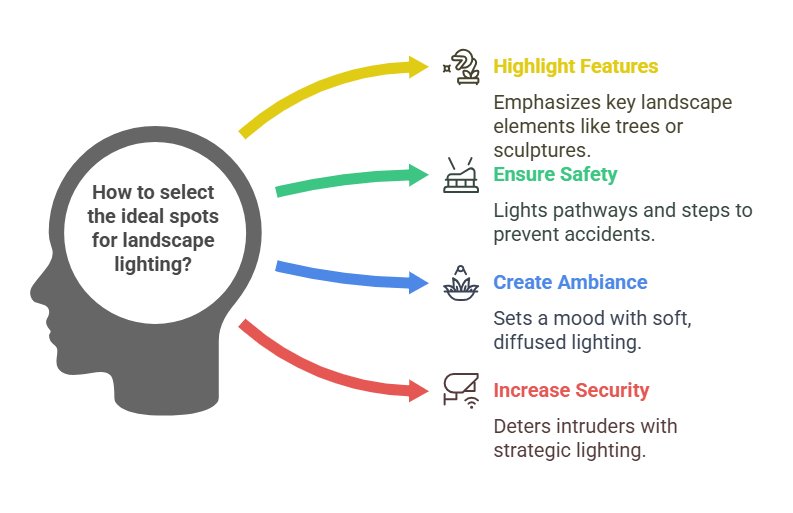
Having grasped the essence of landscape lighting, let’s identify the key areas within your landscape to illuminate. When considering lighting, focus on three core principles: Aesthetics, Safety, and Entertainment. Exceptional landscape lighting encapsulates all these elements.
While the allure of lighting up the entire landscape might be strong, moderation is key. Prioritize strategic illumination over indiscriminate placements. Let’s explore which areas can be highlighted to optimize your landscape’s lighting.
Pathway Lighting
Ensuring well-lit pathways is essential to enhance safety and visibility. This provides smooth navigation and helps prevent potential tripping hazards. Adequate lighting should cover the whole path to ensure a safe journey.
Terrace Lighting
Lightning up the patio is brilliant for those who frequently use their outdoor spaces. Not only does it elevate the visual appeal of the area, but it also maximizes its functionality. Such a setting is perfect for evening get-togethers or a peaceful nighttime retreat.
Deck Lighting
Lighting up decks is indispensable for safe movement in and around the home. Additionally, these lights can amplify the ambience and utility within the home.
Architectural Landscape Lighting
For homes that boast features like stone walls, wooden structures, and rock formations, illuminating them can elevate the entire aesthetic, giving it a sophisticated touch.
Botanical Lighting
Illuminating gardens breathe life into the space during nighttime hours. The glow beautifies the surroundings and invites longer peaceful nighttime strolls. The allure of a well-lit garden is simply hard to resist.
Patio Lighting
Patio lights help provide lights for entertaining and bathe the space in a nice ambience. This is especially important during seasons when it gets dark earlier, allowing you to grill and host guests late into the night.
Deck Lighting
Illuminating decks and steps are necessary to maneuver outside the home. Strategic placement can comfortably define the entertainment area and extend the time spent outdoors.
Garden Lights
Lighting up gardens creates an appealing atmosphere and enhances the beauty of the plants and surrounding yard. This allows you to spend more time in nature and enjoy your glowing garden anytime. As an additional practical benefit, LED lights can stimulate plant growth.
Hardscape Lighting
Hardscapes such as retaining walls, rocks, and wooden arbors come alive at night with the proper lighting. The best hardscape lighting can add an unnoticeable dimension during the day and highlight the natural beauty of your surroundings.
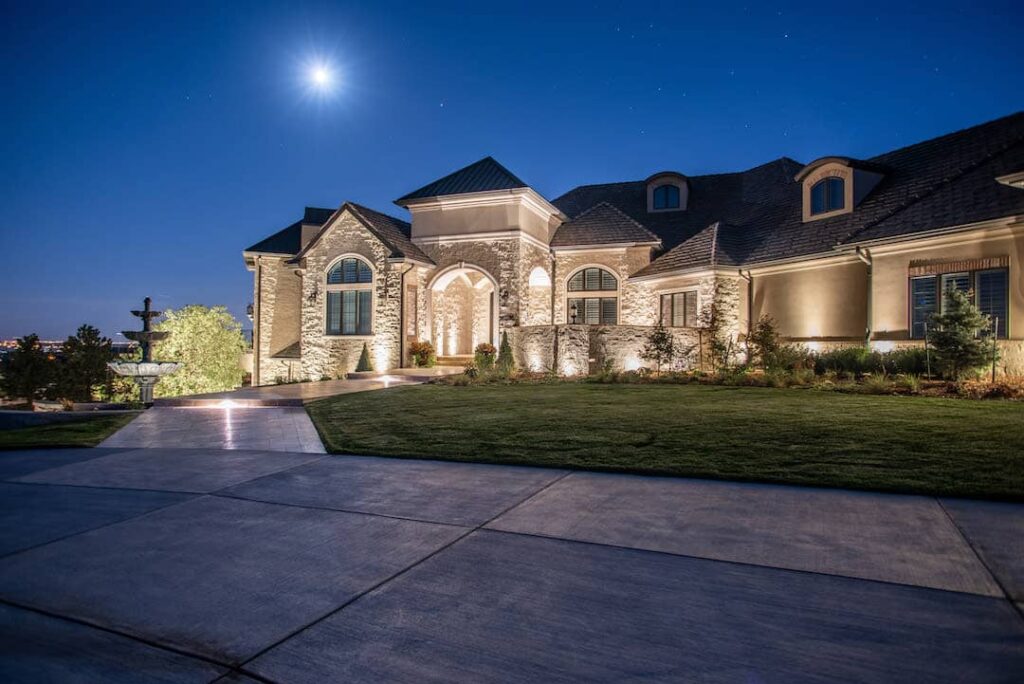
Yard Lights
Proper illumination of your front and back yards will look inviting to guests while discouraging any intruders through increased visibility. Well-placed lights will showcase your home’s landscaping and increase curb appeal.
Pond Lighting
Ponds are a great focal point that the proper lighting can draw attention to. Highlighting ponds and other water features adds drama and intrigue to your landscape.
Aquatic Highlighting
Using ponds as focal lighting points can be both strategic and aesthetically pleasing. Emphasizing these water features showcases their beauty and allows the surrounding landscape to be creatively lit, adding drama and intrigue to the entire setting.
Landscape Lighting Design
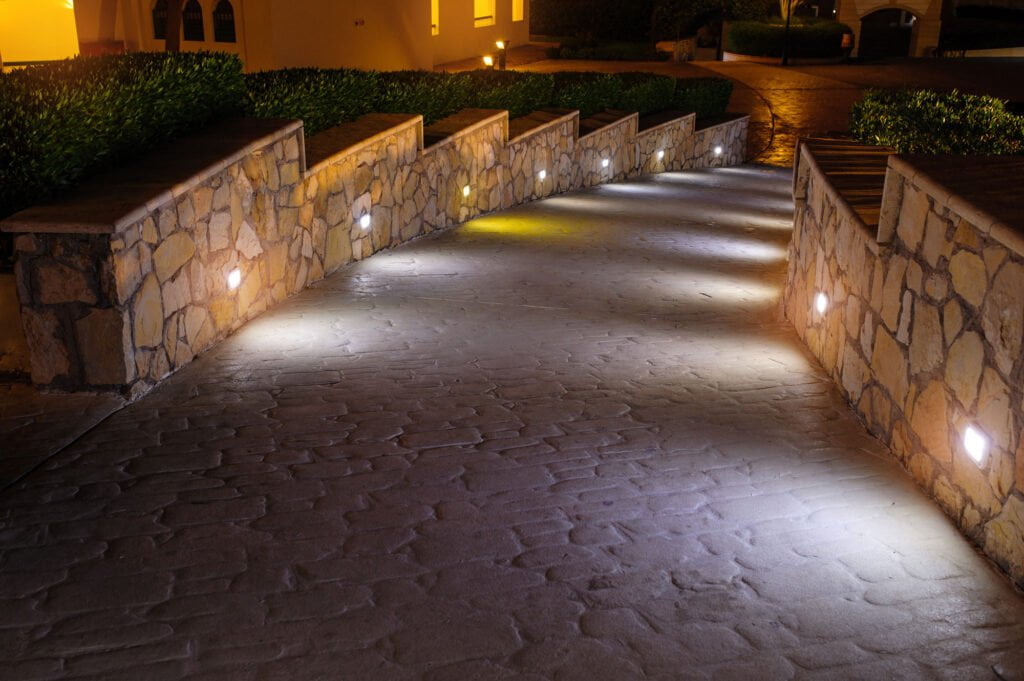
Along with various types of yard lights, different strategies highlight specific areas. The effects of landscape lighting design can create a certain mood or ambience in the space.
Highlighting
Using light to illuminate interesting objects’ shape, colour, and form is known as highlighting. This is achieved by placing floodlights or spotlights at the foot of the feature. The distance and angle of the beam can be adjusted until the desired effect is performed on the plant, statue, or unique architecture.
Silhouetting
Placing spotlights or well-lights behind an object or plant can highlight dramatic shapes that aren’t as noticeable during the day. The light source is hidden, creating a silhouette as it shines towards the path or yard.
Accenting
Accenting is another strategy for emphasizing specific features such as trees, statues, and other décor. This is accomplished by focusing a narrow spotlight on the object from a hidden position, either down or up.
Shadowing
As the name suggests, shadowing creates a shadow on the wall or hardscape behind the item for a moody effect. You can do this by placing a spotlight, well light, or floodlight between the vantage point and the object or plant to be illuminated.
Moonlighting
Moonlighting is a technique that uses spotlights high in trees angled downward to create the effect of moonlight. A soft light fixture bathes the ground below in gentle light, creating soft shadows from the tree’s lower branches.
Washing
Washing is produced by illuminating a large wall or hedge with light at an indirect angle. Floodlights are used to cast an even gentle light in an entertainment area.
Downlighting
Downlighting is a method for accenting planting beds or garden features from above by mimicking natural light. This makes a garden safer and more secure, creating a warm and natural glow. This effect is produced by fixing outdoor lights in a tall trellis, eave, or hardscape.
Up lighting
Up lighting can create different angles of luminescence by placing spotlights or well-lights close to the base of an object. This strategy creates drama with tall structures such as trees or statues by showing off their form from below.
Grazing
If you have flat surfaces, grazing can be used to take advantage of their texture by creating dramatic shadows. This can be done by using healthy lights or hardscape lights to graze the surface of different hardscape items.
Exploring Landscape Lighting Varieties
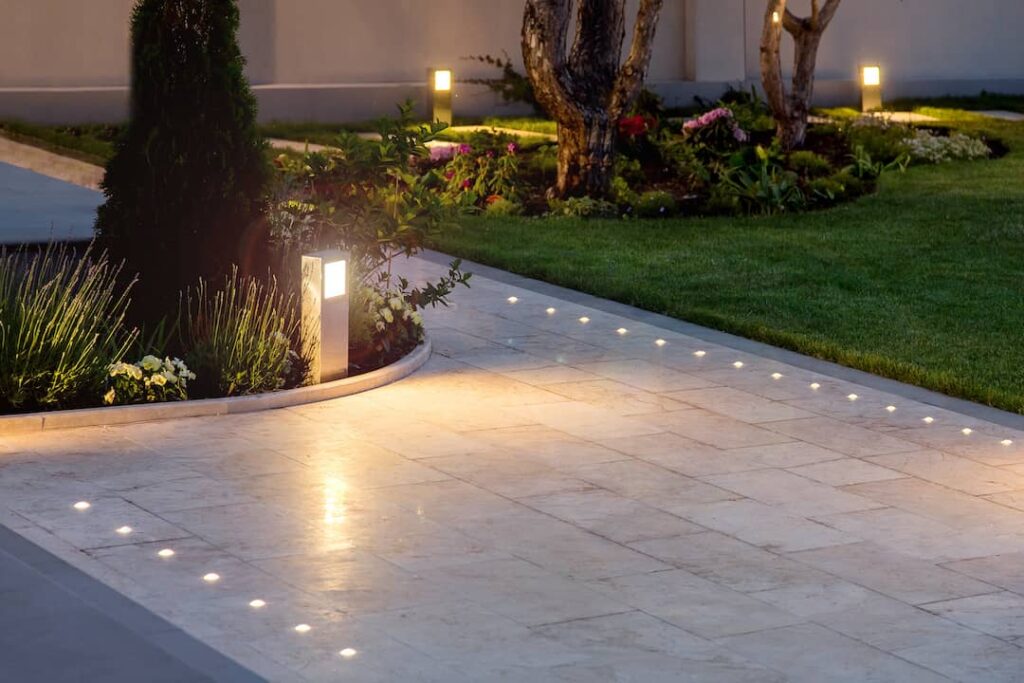
Knowing the different landscape lighting options is vital to determining where to place them. Traditional incandescent bulbs, halogen lights, and LEDs are all choices for illuminating outdoor spaces. However, LEDs are the top pick due to their energy efficiency, longevity, and adaptability. Within the realm of LEDs, there’s a diverse range. Each type serves a specific purpose, so it’s crucial to recognize the function of each to light your landscape best.
1. Spotlights vs. Floodlights
Spotlights and Floodlights are the most potent lighting fixtures, yet serve distinct roles. The core distinction lies in their beam angle. Spotlights emit a more focused beam, usually around 45 degrees. They’re best for emphasizing particular features or focal points. For instance, spotlights are your go-to to accentuate a unique architectural feature.
Conversely, floodlights cast a broader light, spanning approximately 120 degrees. They provide a more general illumination, perfect for amplifying the utility of an area. When setting up landscape lighting, use floodlights for ambience and fine-tune with other light types.
2. Inground Lights
They are designed for ground installation, and inground lights elegantly illuminate pathways and driveways. Their subtle glow enhances both the area’s elegance and visibility. Positioning them beneath garden trees can also beautifully showcase the trees’ full silhouette. Although inground lights are effective standalone, combining them with floodlights can be particularly striking.
3. Outdoor Post Lights
As accent lighting, outdoor post lights delineate the path to your residence. Their glow is ambient, not overpowering, setting a welcoming mood for guests. Depending on the area’s size, taller post lights can be used for expansive areas like driveways, while shorter ones suit nooks. To balance their brightness, it’s critical to determine the correct number of lights for your space.
A helpful guideline is to observe the light spread around a post and place the next one just outside this illuminated zone. For an artistic touch, alternate the lights on either side to enhance driveway allure.
4. Path Lights
While akin to post lights, path lights are more understated. They delineate pathways within your property, adding a charm above the inground lights. Their installation may be slightly more complex and have a heftier price tag. The fixture’s height plays a pivotal role; ideally, they should stand around 14 inches tall to ensure uniform path illumination.
Exploring Landscape Lighting Designs

Diving into landscape lighting requires understanding the varied tactics that can elevate its appeal. Different lighting designs serve other intentions, and blending multiple methods often produces the best outcome. Here’s a closer look at some prevalent landscape lighting designs:
- Highlighting
As implied, this design illuminates specific characteristics of an object, like its colour, shape, or form, to enhance its allure. Spotlights or floodlights positioned at an object’s base work well here. Tweaking the angle and proximity of the light ensures the desired outcome. This design can spotlight statues, flora, or any distinctive landscape feature. - Accent Lighting
While also emphasizing object features, accent lights do so more understatedly. Narrow-beamed spotlights, either from above or below the object, are ideal. Typically, accent lights are optimal for secondary focal points. For instance, while a grand central garden tree might warrant highlighting, its surrounding trees would benefit from accent lighting. Ensure the light source remains concealed when opting for this design. - Shadowing
This method casts an object’s shadow onto walls or other solid structures, introducing a theatrical touch to the setting. Spotlights and well-lights are prime candidates for this design. Position the light strategically to project the shadow of the chosen object. - Downlighting
Replicating the feel of natural illumination, downlighting showers light upon a garden or landscape from an elevated point. While it amplifies the space’s functionality, it might not always accentuate its beauty. - Grazing
Grazing paints the landscape with intense shadows, particularly effective on textured surfaces. A vivid effect is achieved by utilizing lights that cast shadows from various objects onto solid surfaces. - Uplighting
Contrary to downlighting, uplighting shoots beams upwards from the ground. Focusing on specific spots, these lights tend to amplify beauty over functionality. - Washing
Like a vast wall, the washing technique uses an oblique beam angle for an evenly lit expanse. Floodlights are the go-to option for this design, proving optimal for entertainment zones. - Moonlighting
Position spotlights in the canopy to infuse a nocturnal ambience among trees, directing beams downward. Opt for mellow lighting delicately illuminating the ground while forming shadows with tree branches.
Handy Guidelines for Landscape Lighting
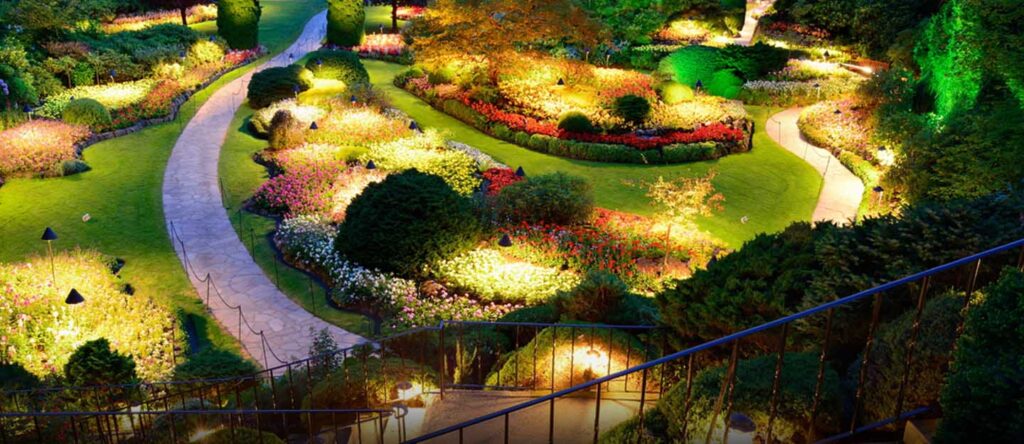
While you’ve already got a grip on the fundamental aspects of lighting up landscapes, we’d like to simplify things further with these handy guidelines:
- DIY Friendly: There’s no need to engage an electrician for your landscape lighting. Given that most landscape lights operate on low voltage, a simple wire stripper is all you need to get started on your own.
- Retrofitting is Key: There’s no rush to replace halogen fixtures if you already have them. Fit them with LEDs, ensuring the base and wattage match, and enjoy the perks of energy-efficient lighting.
- Safety First: If you plan to lay wires underground for the lights, marking the wire routes is critical. This step will help prevent mishaps, like inadvertently cutting through a wire while planting a new sapling.
- Opt for Quality Connections: Steer clear of factory-installed connectors, which can corrode and fail when buried. Instead, rely on gel-filled wires and splice connections explicitly designed for outdoor conditions.
- Balance is Essential: Avoid harsh, strong lights for areas like patios where relaxation is the focus. A subtler approach, such as illuminating surrounding elements like boulders or trees, can create a cosy ambience through indirect lighting.
- Strategize Light Placement: Remember, more isn’t always better. Strategically position your lights to avoid overlaps and ensure every fixture has its purpose.
- Add a Dash of Color: Consider multicolored lights in certain areas for that flair. Modern, bright LEDs, controllable via smartphone, allow you to tweak colour, patterns, and brightness levels. These are particularly great for those who love hosting outdoor gatherings.
With these guidelines, you’re well on achieving a brilliantly lit, functional, and aesthetically pleasing landscape.
Why Choose LED Strips for Your Landscape Lighting?
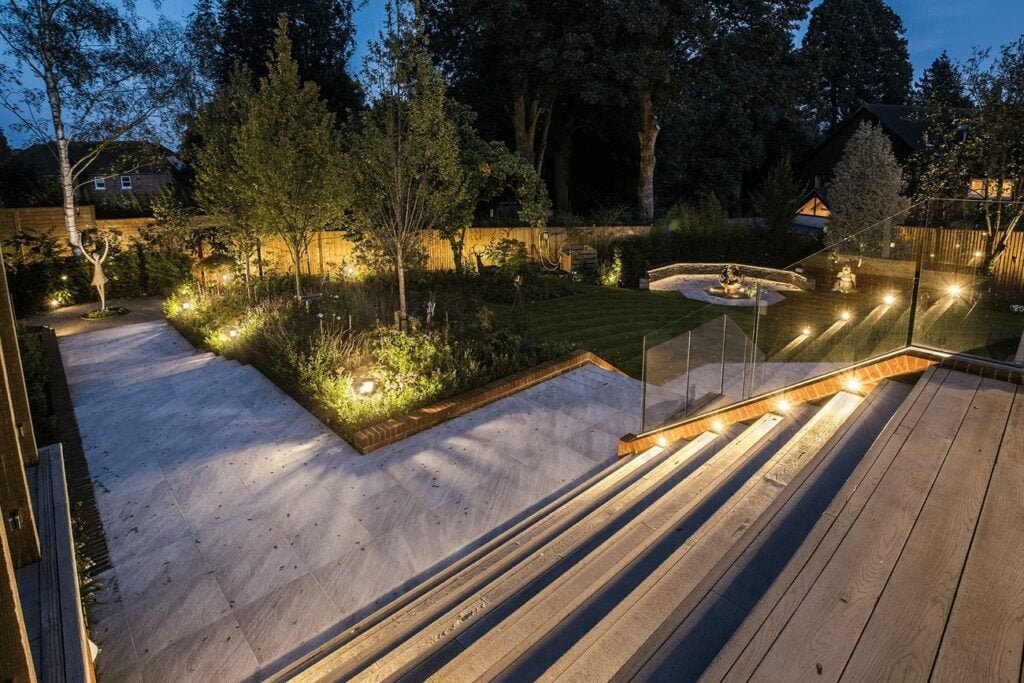
There are plenty of landscape illumination choices, but LED strips stand out. Here’s why:
1. Cost-Efficiency
LED strips are power savers. They consume significantly less energy than conventional bulbs, translating to substantial savings on electricity bills. Given the number of lights required for extensive landscape lighting, opting for power-hungry bulbs can spike your bills. In contrast, LEDs use about 75% less energy than their incandescent counterparts. Rising energy costs mean a noticeable reduction in your monthly expenses.
While LEDs might have a higher initial price, their energy savings quickly offset this cost, making them a wise long-term investment.
2. Longevity
Setting up landscape lighting is a considerable effort; the last thing you’d want is frequent bulb replacements. Here’s where LEDs shine – they typically last 25 times longer than conventional bulbs. In perspective, if a regular bulb burns out in a month, its LED counterpart can stay over two years.
Many LED brands even boast lifespans of up to 50,000 hours, with some exceeding 100,000 hours. Once you’ve set them up, they’ll light up your landscape for a long while.
3. Versatility
Your landscape lighting should be a reflection of your artistic vision. Traditional bulbs, with their limited variations, can sometimes dampen that spirit. But with LEDs, the sky’s the limit. They come in many shapes, hues, and sizes, ensuring there’s always an LED to match your creative spark.
Conclusion
Enhancing a home’s exterior with proper lighting significantly boosts its visual appeal and functionality. Outdoor spaces that are well-lit elevate the experience of evening gatherings, leisurely walks, and relaxed get-togethers. Moreover, the added lighting deters potential trespassers, providing an extra security measure. Getting the lighting right is vital for these benefits to be fully realized. We’ve provided a comprehensive guide to achieving optimal landscape lighting, and we trust it has been of value.
For top-tier LED strips and LED neon flex, look no further than MyLikeLed. We pride ourselves on producing premium LED products, each meticulously tested in advanced laboratories to guarantee exceptional quality. Our LED strips and neon flex have customizable features to suit individual preferences. For unparalleled quality in LED lighting, get in touch with MyLikeLed today!
FAQs
Why should I use LED lights for outdoor lighting?
You should use LED lights for outdoor lighting because they are energy-efficient, long-lasting, and weather-resistant. LEDs consume significantly less power than traditional bulbs, saving you money on electricity. They also last much longer—often over 25,000 hours—reducing maintenance. Plus, many outdoor-rated LEDs are built to withstand rain, dust, and extreme temperatures, making them perfect for patios, gardens, pathways, and driveways.
Are LED lights bright enough for outdoor use?
Yes, LED lights are more than bright enough for outdoor use. In fact, they come in various brightness levels (measured in lumens), so you can choose exactly what you need—whether it’s subtle lighting for ambiance or powerful floodlights for security. LED technology also allows for focused beam angles, meaning you can direct light precisely where it’s needed without unnecessary glare.
Can LED outdoor lights handle harsh weather conditions?
Absolutely. Most outdoor LED lights are designed to be weatherproof and come with an IP (Ingress Protection) rating. A higher IP rating means better protection against water, dust, and dirt. For example, an IP65-rated LED can easily handle rain, wind, and snow—making them suitable for year-round outdoor use.
Do LED lights help improve outdoor security?
Yes, LED lights significantly improve outdoor security. Their instant-on feature, combined with bright, clear illumination, helps eliminate dark areas around your home or business. When paired with motion sensors, LED lights can deter trespassers and alert you to movement. They’re an excellent choice for driveways, entryways, fences, and backyards where visibility is key.
Can I use LED lights for decorative outdoor lighting?
Definitely. LED lights are ideal for decorative outdoor lighting because they come in various colors, styles, and shapes. From string lights and spotlights to color-changing RGB LEDs, you can create stunning landscapes, festive vibes, or cozy atmospheres with ease. Plus, many decorative LEDs are dimmable or smart-enabled, allowing for full control over the look and mood of your outdoor space.

Hi, I’m Xylia Xiong, a sales professional with 14 years of experience in the LED strip light industry. I specialize in providing tailored solutions, leveraging my expertise in LED products and the latest industry trends. Known for effective communication and problem-solving, I’m dedicated to helping lighting manufacturers, importers, and distributors achieve their goals.
Let’s work together to create customized solutions that exceed expectations.
Related Posts

The Best LED Strip Lights You Can Buy Right Now

Comparing WS2811 Vs WS2812B: Key Differences


